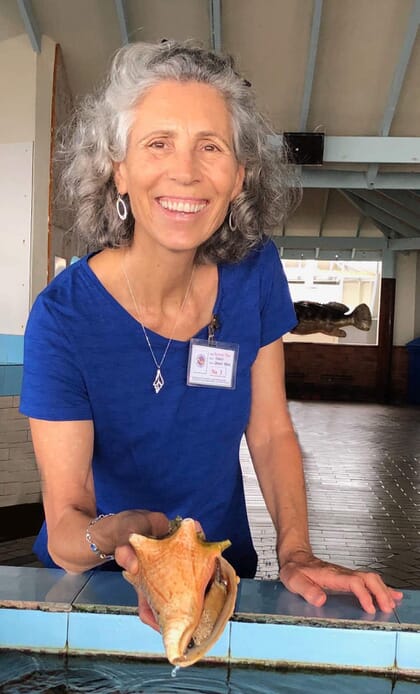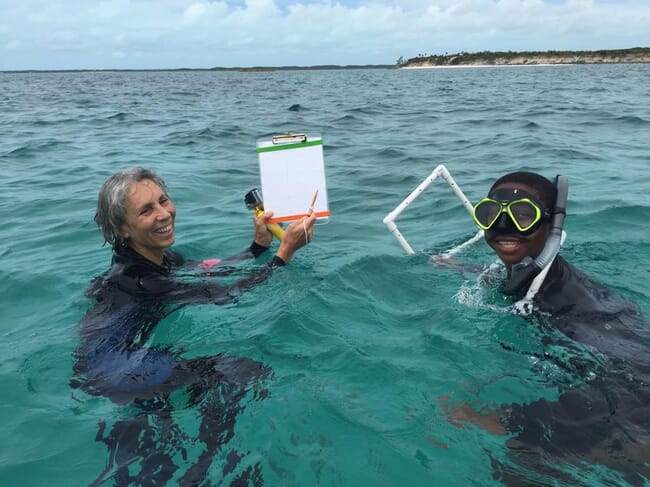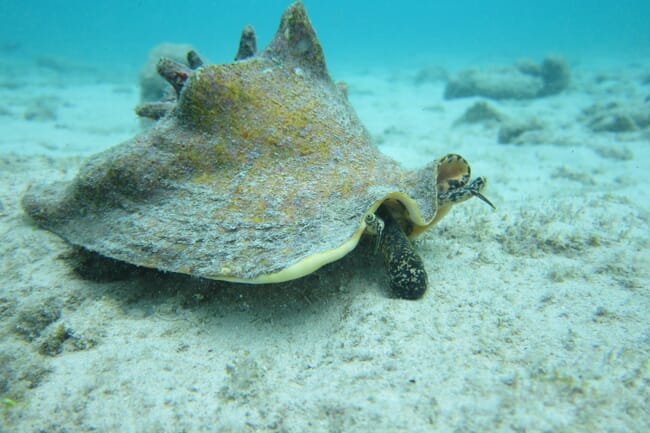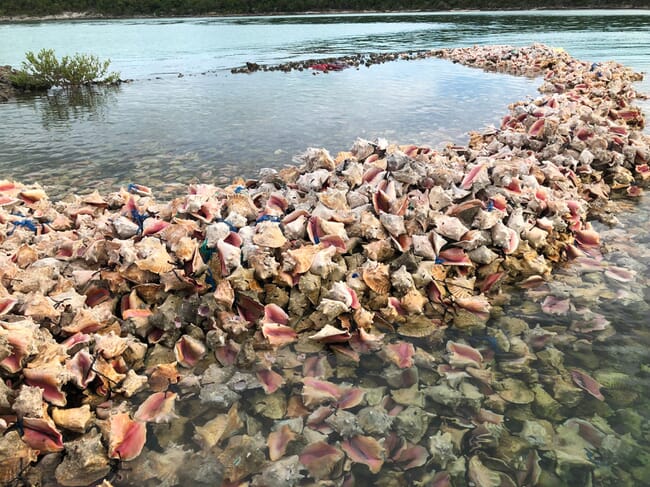
Briefly describe your aquaculture career
My 40-year (and still going strong) aquaculture career began with undergraduate studies at the Florida Institute of Technology (FIT) and summer internships. In the early 1980s, aged 21, I moved to the Turks and Caicos Islands and spent ten years as co-founder and chief scientist of the world’s only production-scale conch farm. After moving back to Florida, I earned my masters and PhD and continued to work with queen conch (Strombus gigas) research, which has included designing and operating seven conch hatcheries of various sizes through the years.
I currently co-lead a conch hatchery in Puerto Rico and The Bahamas mobile queen conch hatchery, and I’m an advisor for the Curacao Sea Aquarium Conch Hatchery. Although the queen conch has been the primary focus of my career, I’ve also worked on other projects, such as hard clam aquaculture retraining for fishers in Florida, spiny lobster pueruli [juvenile] collections in Puerto Rico and Turks and Caicos, and culturing edible sea vegetable halophytes in Florida. My experiences also include teaching, project management and technology transfer, and my focus has always been to work on community-, industry- and/or fisheries-based projects. I’m also passionate about healthy, sustainable seafood and sea vegetable choices and enjoy sharing information through culinary demonstrations.
What drew you to queen conch?
My journey began in 1975 when I was introduced to the species by Bahamian fishermen. Back then I remember thinking that one day the conch would be harder to find because the species is beautiful, a culinary delight and easily fished. Knowing that it is an important way of life for the islands and vital to the ecosystem, I decided that I would learn how to grow it for food and restoration. I never imagined that this encounter would shape my career and that one day I would be known as a global authority on queen conch aquaculture. I was one of the pioneers when queen conch hatcheries began to develop in the 1980s.

How threatened is the species today?
The queen conch is the largest molluscan fishery throughout the Caribbean. It’s second to spiny lobsters in importance. Each country has its own unique set of fishery management regulations that may include a moratorium on collection (as has been the case in Florida since 1986), closed seasons, size and lip thickness of adults, quotas, export bans, and collection method. In 1992, the queen conch was listed on Appendix II of the Convention on International Trade in Endangered Species of Wild Fauna and Flora (CITES). In 1995 the CITES Animals Committee included Strombus gigas in the Review of Significant Trade process, following concerns over the growth of the industry and enforcement issues. The review concluded that local queen conch populations, and hence fisheries, were threatened, despite the species’ survival as a whole not being at risk. One of the committee’s main recommendations was to develop a regional management regime for the species.
Starting in December 2019, NOAA Fisheries initiated a status review of queen conch under the Endangered Species Act. It is anticipated that the results of this review will be available in 2021.
How important is the species in particular regions?
The queen conch is deeply rooted in the way of life of communities in The Bahamas and across the Caribbean and is an economic base for many fishers, restaurants and others in the value chain in many island nations – including The Bahamas, Turks and Caicos, Puerto Rico, Belize, Honduras, and Jamaica.
Describe the importance of aquaculture and restoration in harvesting conch for human consumption and restocking wild populations.
Along with fishery management, the aquaculture of queen conch for sustainable seafood and restoration of wild populations is important for the sake of the species, their ecosystem, and the people who depend on the fishery.
What queen conch aquaculture projects are you currently involved in?
Several! To address the plight of the conch, the FAU Harbor Branch Queen Conch Lab is dedicated to Caribbean-wide conservation and restoration solutions in coordination with fishery management. Its comprehensive programme focuses on projects that repopulate conch populations in overfished Marine Protected Areas (MPA), conch hatcheries for conservation education, research, restoration, and sustainable seafood and community-based training. See conchaquaculture.org and Instagram @queenconch2020 for more details.
I’m the principal investigator (PI) for a Saltonstall-Kennedy NOAA Fisheries-funded queen conch hatchery at Puerto Rico’s Naguabo Fishing Association, where fishers will be trained to operate the hatchery. This is a partnership with Conservación ConCiencia and the Fishing Association. I’m also a science advisor for a new conch hatchery at the Curacao Sea Aquarium and provide training to their team. The Queen Conch Lab partners with the Bahamas National Trust and Department of Marine Resources to repopulate conch in overfished MPAs to increase egg masses and benefit seagrass ecosystems. A new project that I co-lead with Green Island Blue Ocean is the establishment of the first mobile community-based queen conch hatchery for conservation education and restoration in the Exuma Cays, Bahamas.

Word of these hatchery and field projects has spread and I’m regularly contacted by Caribbean communities to help bring solutions to the queen conch decline. As a way to answer this call and to have a regional-wide reach, FAU’s Harbor Branch Queen Conch Lab raises funds through a Save the Queen of the Sea campaign and grant-writing, and has started designing an online and hands-on course called ‘eConch: eLearning for Growing Queen Conch’ to teach queen conch aquaculture to Caribbean communities. This concept was developed from the findings of two 2020 focused planning sessions with partners throughout the Caribbean.
The project’s goal is to jointly develop and beta test an interactive, online course with nine site partners across the Caribbean. It will target a broad audience and be accessible to all levels of education. The course will utilise the recently published Queen Conch Aquaculture User Manual (Davis and Cassar), an 80-page, step-by-step guide with illustrations and photos showing how to culture queen conch during the hatchery and nursery stages. It was published in the Journal of Shellfish Research and is available as an open source document.
The course will also empower communities to become stewards of queen conch and apply their acquired knowledge towards the restoration, research and conservation of this iconic species.
How do the projects compare?
They all have a common theme – growing conch and the passion of those who want to learn to grow it. The differences are in the approaches – the sizes, configurations and locations of the hatcheries. Each one is based on similar techniques but has its own personality. Other differences relate to the communities and their own heritage with the conch.
Describe a typical day in your current role.
My days vary a lot depending on whether I’m on location at the hatchery, in the field, or in the office at Harbor Branch. If I’m on location, I’m working with colleagues, partners, fishers and/or community members to install a conch hatchery, conduct training, grow conch and/or collect conch to establish an egg farm. If I’m in the office, I’m writing grant proposals and manuscripts, ordering supplies, answering emails or attending virtual meetings. As a science advisor for Curacao Sea Aquarium Conch Hatchery, I answer questions and converse on WhatsApp to assist with microalgae and conch cultures. On Tuesdays, I work with my co-workers on our sea vegetable for human consumption project, which includes planting, measuring, harvesting and collecting data on growth and nutrition. We work with halophyte plants – sea purslane, saltwort and sea asparagus that is also known as Salicornia.
What do you enjoy most about your work?
I really enjoy the variety. I enjoy working in Caribbean communities and I love to teach and take project ideas from concept to reality.

What aquaculture-related achievement are you most proud of?
Moving to the Turks and Caicos at 21 and being instrumental in developing and implementing large-scale production techniques for growing queen conch, managing a queen conch hatchery, and training local islanders to work with me. The accomplishment that I will be most proud of is still to come – and that will be full circle for me – training more communities in the Caribbean to grow queen conch for conservation and restoration, using the techniques I’ve developed.
How do you address sustainability concerns in your work?
Using aquaculture for conservation education. The more people know about a species, the more they will understand how to help conserve it, why fisheries management and aquaculture are necessary and what we all can do to help maintain it, its ecosystem and a way of life for the future.
What are some of the challenges of queen conch aquaculture?
There are many applied research questions that still need to be answered. For example, queen conch eggs are collected from the wild. Although we’ve been successful in spawning conch in captivity, this isn’t a reliable source of eggs and more studies on breeding in captivity are needed. Improving the rearing of juveniles for restoration is another topic. Growing the conch to mimic wild conch juveniles will help with their survival in restoration. There are still many questions to answer when it comes to building our knowledge of queen conch restoration to ensure successful release and growth, while climate change also cannot be ignored. How will it affect conch growth, development and survival from the egg to adult stage? Changes in pH – interacting with other variables such as temperature, salinity and nutrients – could dramatically affect larval growth, shell development and survival.
Have you faced any gender-related challenges in your work?
No, I haven’t. Although there have been times throughout my career when I’m the only woman in a meeting or at work, this ratio has changed over the years and it is exciting to see more women in marine science and aquaculture. My focus has always been to do good work and pursue my goals with determination. I have tackled my challenges and accomplishments with perseverance and encouragement.
What advice do you have for women looking to start a career in aquaculture?
I want them to know that there are so many opportunities. I provide advice by mentoring many women – interns, staff, students, co-workers – who work with me or contact me, and I encourage them to pursue and achieve careers in these fields. I also let them know that it takes hard work and dedication. I hope that I provide an example of what can be achieved in the field. I enjoy working and guiding early- to mid-career women and men, including students. The balance of gender and diversity in the workplace is so important.
How do you see your work evolving in the years to come?
In this phase of my career, I’m trying to do as much outreach and technology transfer as possible to share my knowledge of conch rearing in order to leave my legacy for others to use throughout the Caribbean. This is where the majority of my time will be spent for the next decade or more. My ultimate goal is to help establish a conch farm in every nation in the Caribbean.








